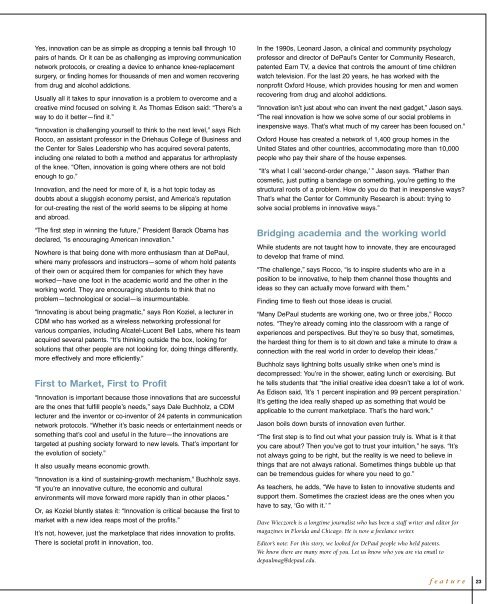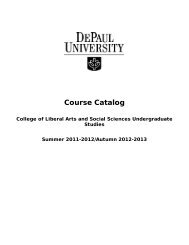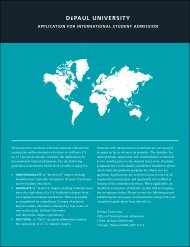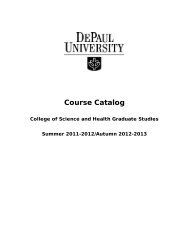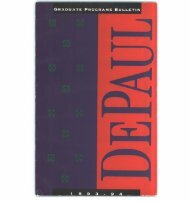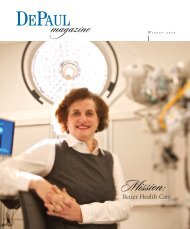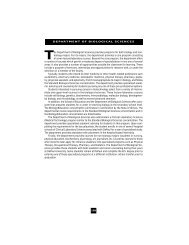Download PDF of Current Issue - DePaul University
Download PDF of Current Issue - DePaul University
Download PDF of Current Issue - DePaul University
- TAGS
- download
- depaul
- www.depaul.edu
You also want an ePaper? Increase the reach of your titles
YUMPU automatically turns print PDFs into web optimized ePapers that Google loves.
Yes, innovation can be as simple as dropping a tennis ball through 10<br />
pairs <strong>of</strong> hands. Or it can be as challenging as improving communication<br />
network protocols, or creating a device to enhance knee-replacement<br />
surgery, or finding homes for thousands <strong>of</strong> men and women recovering<br />
from drug and alcohol addictions.<br />
Usually all it takes to spur innovation is a problem to overcome and a<br />
creative mind focused on solving it. As Thomas Edison said: “There’s a<br />
way to do it better—find it.”<br />
“Innovation is challenging yourself to think to the next level,” says Rich<br />
Rocco, an assistant pr<strong>of</strong>essor in the Driehaus College <strong>of</strong> Business and<br />
the Center for Sales Leadership who has acquired several patents,<br />
including one related to both a method and apparatus for arthroplasty<br />
<strong>of</strong> the knee. “Often, innovation is going where others are not bold<br />
enough to go.”<br />
Innovation, and the need for more <strong>of</strong> it, is a hot topic today as<br />
doubts about a sluggish economy persist, and America’s reputation<br />
for out-creating the rest <strong>of</strong> the world seems to be slipping at home<br />
and abroad.<br />
“The first step in winning the future,” President Barack Obama has<br />
declared, “is encouraging American innovation.”<br />
Nowhere is that being done with more enthusiasm than at <strong>DePaul</strong>,<br />
where many pr<strong>of</strong>essors and instructors—some <strong>of</strong> whom hold patents<br />
<strong>of</strong> their own or acquired them for companies for which they have<br />
worked—have one foot in the academic world and the other in the<br />
working world. They are encouraging students to think that no<br />
problem—technological or social—is insurmountable.<br />
“Innovating is about being pragmatic,” says Ron Koziel, a lecturer in<br />
CDM who has worked as a wireless networking pr<strong>of</strong>essional for<br />
various companies, including Alcatel-Lucent Bell Labs, where his team<br />
acquired several patents. “It’s thinking outside the box, looking for<br />
solutions that other people are not looking for, doing things differently,<br />
more effectively and more efficiently.”<br />
First to Market, First to Pr<strong>of</strong>it<br />
“Innovation is important because those innovations that are successful<br />
are the ones that fulfill people’s needs,” says Dale Buchholz, a CDM<br />
lecturer and the inventor or co-inventor <strong>of</strong> 24 patents in communication<br />
network protocols. “Whether it’s basic needs or entertainment needs or<br />
something that’s cool and useful in the future—the innovations are<br />
targeted at pushing society forward to new levels. That’s important for<br />
the evolution <strong>of</strong> society.”<br />
It also usually means economic growth.<br />
“Innovation is a kind <strong>of</strong> sustaining-growth mechanism,” Buchholz says.<br />
“If you’re an innovative culture, the economic and cultural<br />
environments will move forward more rapidly than in other places.”<br />
Or, as Koziel bluntly states it: “Innovation is critical because the first to<br />
market with a new idea reaps most <strong>of</strong> the pr<strong>of</strong>its.”<br />
It’s not, however, just the marketplace that rides innovation to pr<strong>of</strong>its.<br />
There is societal pr<strong>of</strong>it in innovation, too.<br />
In the 1990s, Leonard Jason, a clinical and community psychology<br />
pr<strong>of</strong>essor and director <strong>of</strong> <strong>DePaul</strong>’s Center for Community Research,<br />
patented Earn TV, a device that controls the amount <strong>of</strong> time children<br />
watch television. For the last 20 years, he has worked with the<br />
nonpr<strong>of</strong>it Oxford House, which provides housing for men and women<br />
recovering from drug and alcohol addictions.<br />
“Innovation isn’t just about who can invent the next gadget,” Jason says.<br />
“The real innovation is how we solve some <strong>of</strong> our social problems in<br />
inexpensive ways. That’s what much <strong>of</strong> my career has been focused on.”<br />
Oxford House has created a network <strong>of</strong> 1,400 group homes in the<br />
United States and other countries, accommodating more than 10,000<br />
people who pay their share <strong>of</strong> the house expenses.<br />
“It’s what I call ‘second-order change,’ ” Jason says. “Rather than<br />
cosmetic, just putting a bandage on something, you’re getting to the<br />
structural roots <strong>of</strong> a problem. How do you do that in inexpensive ways?<br />
That’s what the Center for Community Research is about: trying to<br />
solve social problems in innovative ways.”<br />
Bridging academia and the working world<br />
While students are not taught how to innovate, they are encouraged<br />
to develop that frame <strong>of</strong> mind.<br />
“The challenge,” says Rocco, “is to inspire students who are in a<br />
position to be innovative, to help them channel those thoughts and<br />
ideas so they can actually move forward with them.”<br />
Finding time to flesh out those ideas is crucial.<br />
“Many <strong>DePaul</strong> students are working one, two or three jobs,” Rocco<br />
notes. “They’re already coming into the classroom with a range <strong>of</strong><br />
experiences and perspectives. But they’re so busy that, sometimes,<br />
the hardest thing for them is to sit down and take a minute to draw a<br />
connection with the real world in order to develop their ideas.”<br />
Buchholz says lightning bolts usually strike when one’s mind is<br />
decompressed: You’re in the shower, eating lunch or exercising. But<br />
he tells students that “the initial creative idea doesn’t take a lot <strong>of</strong> work.<br />
As Edison said, ‘It’s 1 percent inspiration and 99 percent perspiration.’<br />
It’s getting the idea really shaped up as something that would be<br />
applicable to the current marketplace. That’s the hard work.”<br />
Jason boils down bursts <strong>of</strong> innovation even further.<br />
“The first step is to find out what your passion truly is. What is it that<br />
you care about? Then you’ve got to trust your intuition,” he says. “It’s<br />
not always going to be right, but the reality is we need to believe in<br />
things that are not always rational. Sometimes things bubble up that<br />
can be tremendous guides for where you need to go.”<br />
As teachers, he adds, “We have to listen to innovative students and<br />
support them. Sometimes the craziest ideas are the ones when you<br />
have to say, ‘Go with it.’ ”<br />
Dave Wieczorek is a longtime journalist who has been a staff writer and editor for<br />
magazines in Florida and Chicago. He is now a freelance writer.<br />
Editor’s note: For this story, we looked for <strong>DePaul</strong> people who held patents.<br />
We know there are many more <strong>of</strong> you. Let us know who you are via email to<br />
depaulmag@depaul.edu.<br />
f e a t u r e<br />
23


